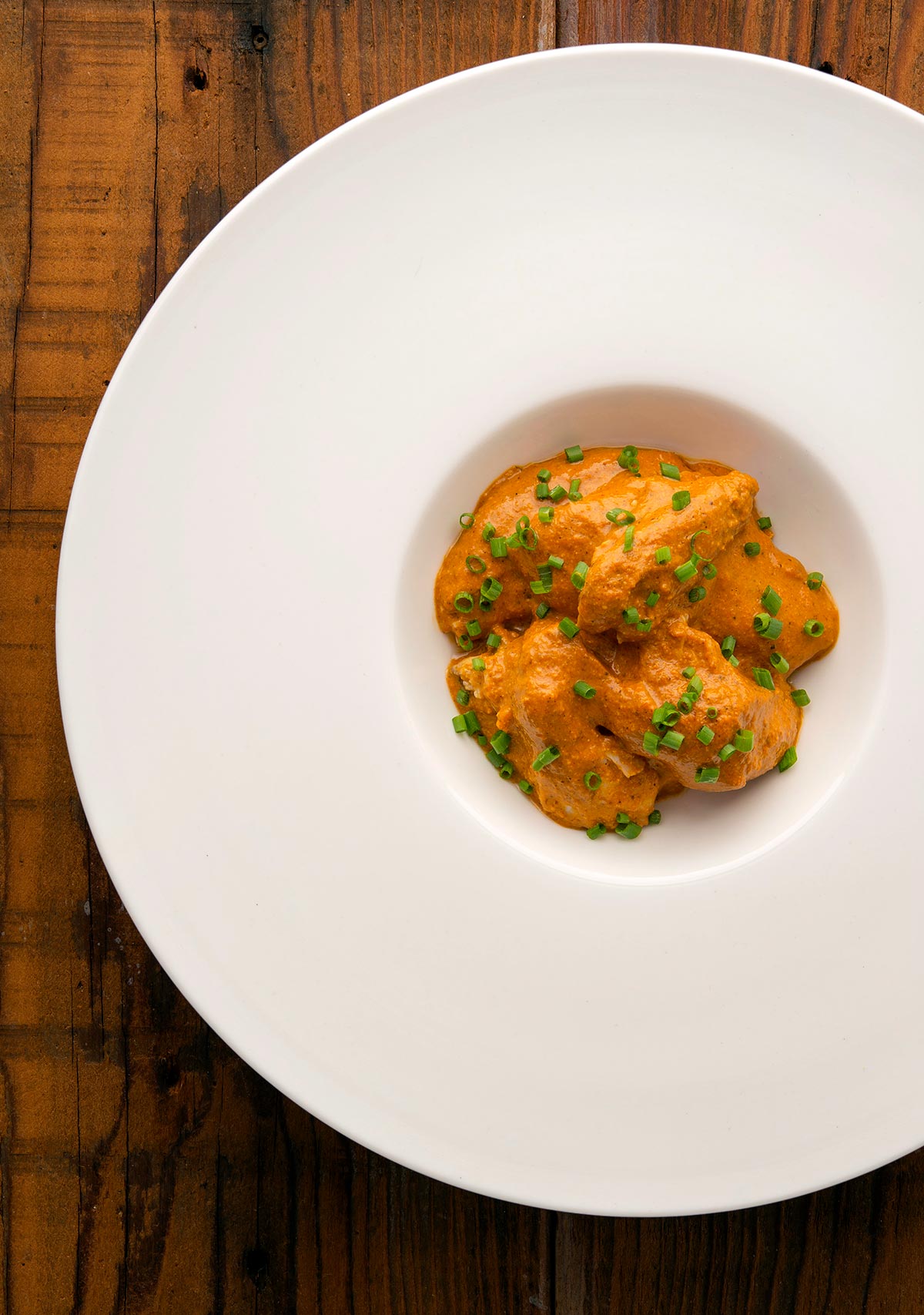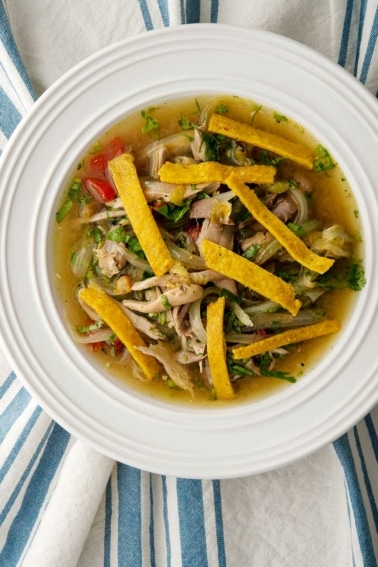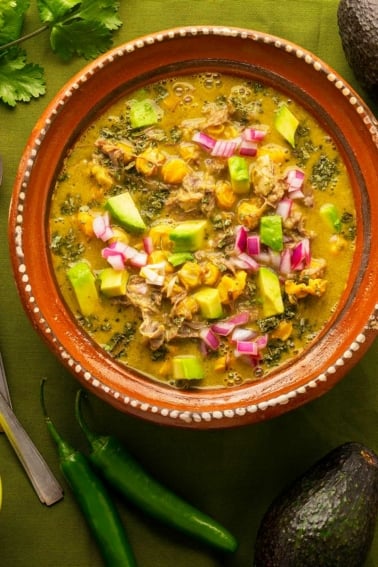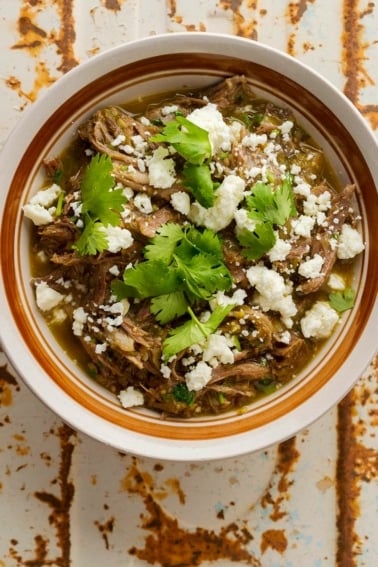As an Amazon Associate I earn from qualifying purchases.
File Mexican chirmol sauce as one of those damn cool things you can make from random ingredients. Chirmol is basically a simplified mole, which is a good thing since mole can be an all-day affair.
Chirmol is not. Pronounced “cheer-moll,” it is a specialty of the Mexican state of Tabasco. Keep in mind this is not the Guatemalan version of pico de gallo, which is also called chirmol.

Mexican chirmol hinges on chiles, ground up pumpkin seeds, tomatoes, onion and garlic, as well as various herbs and spices. You will also want some stale tortillas or tostadas lying around.
This sauce is very often paired with crab, which is what I did here.
I used Dungeness crab, a) because I had it, and b) because the original dish calls for cangrejo, not jaiba. In Latin American Spanish, cangrejo is typically a walking crab, often a land crab, where jaiba is basically the blue crab we see in the Chesapeake and the Gulf. That said, the crab police won’t come to your door if you use blue crab.
No crab? Well, chirmol is great on basically everything. I’ve seen it put on beef, chicken and pork, as well as lobster and fish. So yeah, have at it.
The core of my chirmol recipe is from the book Cocina Familiar En El Estado De Tabasco, which can be hard to find. I’ve also seen other versions here and there, and this is an amalgam of them all.
There are a few unusual ingredients in chirmol to make it truly authentic, but I’m listing these as optional because not everyone has, say, hoja santa lying around.
Once made, chirmol will keep in the fridge for a couple weeks. It also freezes well. I like to triple this recipe, so I can have pint tubs of it in the freezer for when I happen to have crab… or pheasant, turkey, venison, etc., etc. Like I said, this stuff is great on everything!
If you like this recipe, you will like some similar ones, such as mole coloradito, or mole amarillo, or pipian rojo. All are kinda-sorta similar looking Mexican sauces, but they all taste very different.
Chirmol Tabasqueno
Ingredients
- 3 stale tortillas (or tostadas)
- 3 to 5 ancho chiles, stemmed and seeded
- 1 head garlic, cloves separated but not peeled
- 1 white onion, peeled and quartered
- 1/2 pound Roma tomatoes, halved lengthwise
- 1/3 pound pepitas or pumpkin seeds
- 3 cloves
- 1 tablespoon achiote paste (optional)
- 1/2 teaspoon anise seeds (optional)
- 1 hoja santa leaf or small bunch of epazote (optional)
- 2 tablespoons lard or olive oil
- 1 pound crabmeat, or whatever else you want this sauce on.
Instructions
- Get a large, heavy frying pan or comal very hot. Partially char the stale tortillas; you want lots of black marks, but don't blacken them totally. If you are using tostadas, no need for this.
- Briefly toast the ancho chiles, pressing down on them with a spatula. You want to just see some blistering, so maybe 10 to 30 seconds per side. Submerge all the toasted chiles in warm water.
- Arrange the onions, garlic and tomatoes on the hot pan to char them. You want serious blackening here. The tomatoes will take the longest, and don't be tempted to move them too soon or you'll leave all the good blackened bits in the pan. If that happens, scrape it up immediately and set the scrapings aside.
- In another pan, toast the pumpkin seeds over medium-high heat until they start to pop. Move to the bowl of a blender. Crush up the toasted tortillas and put them in the blender, too, along with the cloves, achiote and anise seeds, if using. Add enough water to the blender to turn this all into a runny paste. TIP: If you happen to be braising some meats, use some of the broth instead of water. Pour the contents of the blender into a large bowl.
- When the vegetables are nicely charred, peel the garlic, then add everything to the blender with the soaked chiles and the hoja santa leaf, if using. Add some of the chile soaking water and blend this to a puree, too. Add it to the bowl and mix well. Add salt to taste.
- Heat the lard in a pot over medium-high heat, and when it's hot, add the chirmol. Stir well to combine and drop the heat to low. Let this simmer 15 to 20 minutes. Serve over cooked crabmeat or whatever meat you have, garnished with cilantro or chives.
Nutrition
Nutrition information is automatically calculated, so should only be used as an approximation.






First off, I really enjoy your posts; thank you for this blog. Second, is a question: So my grocery store curbside pickup shooper subbed pepitas for sunflower seeds… Can the sauce be made with those instead?
Keaton: Yes, they can, actually.
Wonderful, thank you!
OK so finally was able to cook it for a simple midweek dinner of griddled leftover polenta cakes (hey it’s sorta like corn sopes) topped with scrambled eggs and your chirmol. Dinner riff on breakfast papadzules.
Wife and child liked it a lot! Especially that it was much more subtle than my normal sauces. 1/2 dried ancho, 1/2 aji limons. Used the achiote paste, fresh epazote, anise seed. Have pics if interested. Reminded me of the Yucatan.
Lots of leftover sauce that is coming out with chips for shelter snacking! Thanks Hank.
I was underwhelmed by the resulting paste. I don’t have hoja santo and my wife is fussy about anise/licorice flavors so i cut the anise seed to 1/4 tsp. The other issue is that my achiote past turner out to be achiote verde (i must have grabbed that by mistake at some point). That was the extent of my changes. I was surprised at how thick this becomes. When cool, it is almost a gelatinous solid.
I don’t like to pitch anything edible into the bin so i tweaked. I added most of the remaining block of achiote verde (probably two or slightly more ounces total of a 3 oz block) of the achiote verde paste. I also added some chicken bouillon base and water to thin it a bit and 1/4 tsp of MSG. This was much better than the original finished product ( i also pounded about a 1/4 tsp of star anise and added that). I would now put this to food without fear of kickback from my family.
Chuck: Yeah, achiote verde is absolutely nothing like achiote rojo. And yes, it becomes a paste. It is supposed to. When you reheat it you add water as needed. Or not, depending on what you are doing with it. I guess I should have been clearer about that. Sorry. Next time try it with the red achiote. You will get a very, very different result.
Hi Hank
Why did my sauce come out much darker; the color of anchos? I used 3.
Peter: Probably. You used the tostadas, yes? That and the pepitas lighten it up a lot.
Just to verify. When you say ancho peppers, you are referring to dried pablanos, right?
Finn: Yes, dried, ripe poblanos.
It looks great! Unfortunately, fresh Mexican ingredients are not easily found here. Are there any acceptable substitutions for hoja santa, epazote, and achiote? Or should I just do without?
Steven: Where do you live? You might be surprised. I’ve actually made this without achiote, hoja santa or epazote and it was still good. As for achiote, it’s also called annatto, and I have seen it in many American supermarkets, even in rural ones. Another possible sub for it would be mild paprika. To get a bit of the hoja santa flavor, a little glug of root beer into the mix will get you close. Yeah, root beer. Trippy, eh?
I’m in Toronto, Canada.
Steven: There are dozens and dozens of Latin markets in Toronto. I personally have been to several. Google “Latin market Toronto” for the ones nearest to you.
I just have to say I like how you craft your words. And by extension, I like how you write your recipes. They are so easy to understand and follow. Not too much verbage, exact but not spare, humor without too much exaggeration. Very few bells & whistles, which I really like. You present yourself straight up and make me want to try [most] of what you post. But even without a recipe, your writing pulls me in with every word. So refreshing!
Diane: Thank you so much! What a lovely compliment.
Interesting – in the Yucatan a local chef there taught me Sikil P’ak, which looks roughly similar except for the tortillas which I assume help smooth out/stabilize the emulsion (the local rustic versions were more salsas than sauces esp since they didn’t hull the pepitas, just tossed em on the comal). Great with tortillas or chips. Makes sense, I assume the maya spread pepita-based sauces/salsas in variants all over the region.
He was cooking in a 1-star hotel restaurant so he cross-riffed it as a complex, silky sauce more like yours, though he wasn’t frenchifying it or anything – all traditional ingredients. Silky smooth but green since he was using tomatillos not tomatoes (interestingly he wasnt using achiote even though annato trees grew in every yard). It was for breakfast papadzules; I still make it every now and then for weekend brunch since it’s so elegant and the wife doesn’t like cream and butter in everything.
Bayless has a good version for papadzules that approaches yours, lots of extra steps that make it more like a creamy siikil than the “standard” pepita-and-epazote simply papadzule sauce you mostly get. Comes out sort of halfway between green papadzule sauce and chirmol in color.
Big bag of pepitas in the Covid freezer and epazote in the back yard, so I’ll give it a shot tonight, thanks.
This one looks great, Hank. I can’t wait to make it. It’ll give me a good excuse to go out and get some crab too!
G’Morning Hank. This looks great, but I was wondering, is this supposed to be a thin sauce like tabasco, or maybe a little thicker?
Joyce: As you can see, it is a thick sauce. Tabasco sauce is from Louisiana. It has nothing to do with the Mexican state of Tabasco.